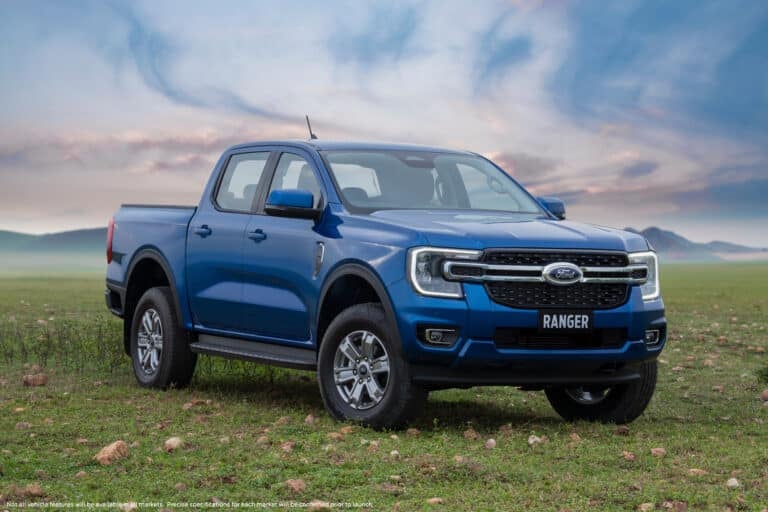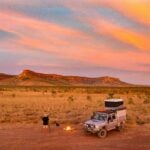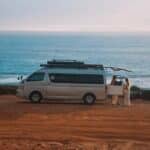… And a caravan that kinda does!
Words by TIM SCOTT Images by BRETT HEMMINGS
Despite having a carpark full of flagship ute models, black this and wild that and some lurid paint, the wallflower Mazda BT-50 got the gig to tow the Nova Terra Sportz 16-foot van for the day. The original towing pick, armed with all sorts of dress-up items, didn’t have the vital electronic brake controller that the BT-50 did. And in the end the Mazda’s business-like gun metal grey paint looked great against the Nova’s grey with orange highlights that were enough to stand out during the dull day that eventuated weather-wise.
The Ford-Mazda engineering co-share between the BT-50 and Ranger is old news but the way the two marques package the mechanicals is still remarkably different. As a buyer, spending your weekends travelling between dealers (after the internet research of course) you will immediately notice the flash workshop that is the Ranger WildTrak’s cabin in stark contrast to the East European cold war ambience of the BT-50, even in top flight XTR and GT spec. Okay, maybe that’s a bit harsh but a straight comparison is vivid – anyway that’s not what we’re doing here but I just wanted to point out something that doesn’t actually translate what the towing performance is like, more the bowerbird attractions you may want as a driver while you’re doing it.
So, spritely five-cylinder 3.2-litre turbo-diesel and six-speed auto in the BT-50 is rewarding with urge, although the auto had periods when it wasn’t quite sure what you wanted to hear or chose its own playlist. I thought it was the indecision of a quick kickdown that caused a falter in cog selection but then it hunted at traffic lights too. Given the press car had a few kays under its belt I gave it the benefit of the doubt. Considering other symptoms of journalistic abuse such as a half-arsed driver’s window operation I may be right but then anecdotal evidence of transmission issues with the BT-50 also needs some acknowledgement.
A kick in the back every now and again wasn’t so bad in the leather upholstered seats, electrically adjustable apart from lumbar, which was manual. The seats are comfortable, and the leather the only real visible nod to luxury appointments internally. On the outside we were graced with bullbar, Lightforce spotties, side-steps and black factory alloys plus a tonneau cover. Practical, not overkill.
Further practicalities were, as we mentioned, the brake controller, (obviously) a factory towbar set-up, and the four-wheel-drive suite that includes hi/low 4X4, Hill Launch Assist and Hill Descent Control and a lockable rear differential. As you now expect there was Traction/Dynamic and Roll Stability controls and the ABS but the BT-50 from XT spec up has Trailer Sway Control too. The latter switches off when you enter 4X4 low-range.
The Mazda has a maximum tow capacity of 3500kg in keeping with its peers, and allows up to 350kg on the ball. We were never going to challenge either with the Nova Terra Sportz 16-foot model with a specified ATM of 2666kg and 276kg ball weight. However, once we’d dropped on the DO35 coupling to the pin and headed off across the Blue Mountains from Sydney RV, the challenge was to find something to complain about. We’d already been impressed by the stable ride the ute offered, unladen too, with very little of the usual jittery choppiness these cargo carriers display when empty on leaf-sprung rear ends. Hitched up, it was a real surprise to have a combination that felt properly connected, if you’ll pardon the expression; it was smooth, with no shunting, clunking or associated racket that can remind you of the glory days of steam, or Sydney’s City Rail. On these day shoots we have very little set up time, we’ve no cargo to reposition and water tanks are always empty, everything is unloaded and rides can be unsettled, not always reflecting fairly on tow car or van, but this combination were rock solid. Perfectly behaved.
The road over the Blue Mountains to Lithgow varies from sweeping bends, 80km/h dual-lane sections over new bitumen, and the old highway – which is pretty rough, repaired and slow-going. An enjoyable drive.
After the shoot by Lake Wallace at Wallerawang – a great camping spot we can recommend from personal experience – we took the rough dirt forestry roads up into the hills behind Lithgow. Frequented by heavy logging trucks, as you’d expect, there were corrugations aplenty and we had some skittish moments, and a little light complaint from the combination as I inconsistently applied the throttle hard while negotiating the roads. Sometimes to see what the rig would do and sometimes more urgently in response to photographer Brett’s radio warnings about oncoming traffic.
The only wayward moment occurred under heavy braking downhill when that uncertain feeling surfaced, as it does over loose corrugations, when everything appears to be floating and slowing a little less than you might like! More me being unnerved than anything and we pulled up fine, albeit washed in the trailing dust swirl that envelops such a manoeuvre.
The BT-50 retains qualities of a work vehicle that are lost on it’s dressed-up badge sibling. While that might not matter to those using their utes for light duties, the direct and positive feel of rack and pinion steering over electronic is great in the
BT-50, as is throttle control and uncluttered visuals for the driver. No constant pinging and multi-coloured lights competing for your attention, although I didn’t get on with the Alpine console screen. And the Bluetooth connection was erratic.
While I found the driver’s position to be ideal for me ergonomically, the cabin space in the rear is fairly representative of utes, although the front two seats have scalloped backs to provide more knee/legroom for rear seat passengers, and there’s a little bit of storage allowance under the main back seat. BT-50 owners are given between 1082, 1095, and 1164kg of payload in the tray, before you start eating into that with your towball weight and humans, etc. which is not inconsequential.












